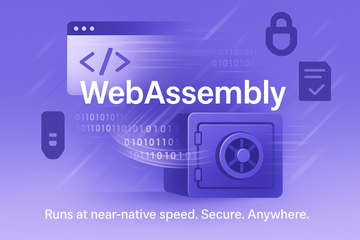You ever tried running a high-powered game or a computationally-intense crypto wallet right in your browser and thought, “There’s no way this is as fast as desktop”? Well, you’re not wrong—or at least, you weren’t. Enter WebAssembly (WASM), the unsung hero quietly powering some of the snappiest applications and crypto tools in your browser, and, believe it or not, way beyond it. Let’s peel back the curtain on this technology—because it’s not just for web whizzes or blockchain nerds anymore.
Cracking the Code: What Exactly Is WebAssembly?
Alright, let’s get real for a minute. Despite the intimidating name, WebAssembly isn’t some mystical language from another realm. At its core, WASM is a binary instruction format—think of it as the lingua franca of digital machines, sort of like turning a meaty steak of C++ or Rust code into easily-digested nuggets your computer can wolf down. No more waiting for sluggish scripts to chug along; WASM brings programs to life at nearly the same speed as your desktop apps.
And you know what? It’s not meant to replace good old JavaScript but to work alongside it, letting the browser do some really heavy lifting without breaking a sweat.
Why Wasm Isn’t “Just Another Plugin”
Remember how Flash or Java applets were supposedly going to make the web fast and fancy? Look how that turned out—bit of a trainwreck, honestly. WASM dodges those pitfalls because it’s built right into browsers like Chrome, Firefox, and even Edge. It’s part of the web’s DNA now, not some dodgy add-on you cross your fingers and hope will work.
Security? Oh, it’s baked right in. WASM runs in a sandboxed environment, away from your sensitive browser innards. That means your private keys or Trezor and Ledger wallets aren’t just dangling out in the breeze (and yes, crypto hardware wallet companies like Trezor and Ledger are starting to take notice—more on that soon).
Behind the Scenes: Binary & Text Under the Hood
If you really want to nerd out, WASM actually comes in two flavors: the compact .wasm binary file your browser reads in a blink, and the human-readable .wat format that lets developers peek in and debug. Think of .wat as the Rosetta Stone for those who want to see what’s happening but without the headache of pure binary.
What does that mean for you? Lightning-fast browsing, apps that don’t lag like they’re stuck in molasses, and tools (like some next-gen crypto wallets) that can actually check signatures and verify transactions locally. If you’re used to hardware-paced security checks, seeing that speed in your browser almost feels… magical.
So, Why Does Crypto Care About WASM?
This is where it gets spicy for our crowd—the world of decentralized money isn’t just about ledger entries; it’s about secure, portable applications. Most crypto folks want wallet operations to stay private and safe, but also usable anywhere—laptop, phone, desktop, you name it. Enter WASM as the ultimate enabler.
- Compatibility: You can compile C++ or Rust crypto wallet code (the kind used by Ledger or Trezor) straight to WASM, and suddenly that same code runs in the browser, mobile device, or new environments, no problem.
- Security: Remember, browsers sandbox WASM code, meaning those sensitive cryptographic operations don’t spill out into the wild.
- Speed: Signature verification, hardware wallet communication, privacy-preserving cryptography? WASM helps them run fast and smooth—even when hundreds of folks pile on to use a web wallet at once.
Not Just for Browsers Anymore
Here’s the twist: WASM was brewed up for browsers, but it didn’t stop there. It plays just as nicely outside them—on servers, IoT gadgets, and yes, even blockchain nodes.
Ever heard of smart contracts running on blockchains like Polkadot or EOS? Many use WASM as the engine under the hood. And in the hardware wallet universe, developers love the idea of one codebase powering both firmware (the code running inside your Trezor or Ledger) and the software communicating with it—thanks to WASM, that dream is getting closer to reality.
Let’s Talk Use Cases—And a Few Tangents
You might wonder: 'What’s in it for me if I’m not building a crypto wallet from scratch?' Well, WASM quietly supports things like:
- In-browser emulation—think retro games playing flawlessly online
- Photo and video editing tools (like Figma or advanced photo editors) that actually work in your browser, not just limp along
- Scientific simulations or data visualization tools for researchers, students, and tinkerers
- And yes, secure transaction signing for Trezor and Ledger wallet browser extensions or web apps
And while we’re here—let’s be honest. Sometimes 'tech that just works' is all you need. Ever stumble across a site that loads a 3D model in seconds or does cryptographic magic in your browser without crashing? WASM’s probably lurking in the background, doing all the heavy lifting while you take the credit.
The WASM Ecosystem: Still Young, but Growing
Is everything perfect? Not yet. Sure, you can build wallet interfaces or even simple desktop apps that run anywhere thanks to WASM, but you might wrestle with debugging (binary code isn’t the easiest to troubleshoot!) or compatibility outside major browsers. There are still some kinks to iron out on the tooling side, and running bleeding-edge cryptography might require careful audits to keep hackers at bay.
But with more companies jumping in—hardware wallet makers like Trezor pushing WASM modules for safer in-browser signing, or Ledger experimenting with more portable codebases—there’s reason to believe the web’s about to feel a whole lot faster, safer, and more flexible.
Quick Takeaways Before You Go
- WASM lets demanding code run fast and safe, everywhere from browsers to hardware wallets
- It bridges the gap between secure crypto hardware (like your Trezor or Ledger) and web interfaces you actually want to use
- Beyond crypto, WASM powers a wave of new, high-performance web and desktop experiences you’ll notice the next time you’re not staring at a spinning “loading…” icon
Final note? Next time you’re verifying that Bitcoin transaction or tweaking some slick online editor, spare a nod for WASM humming away quietly beneath it all. Sometimes the most powerful things hide in the background—unnoticed, but making all the difference. And isn’t that how the best tech should be?











